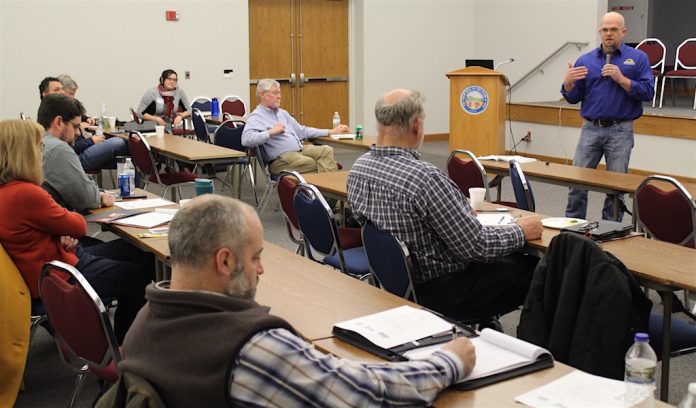
REYNOLDSBURG, Ohio — The opportunity for locally raised and processed meats is strong right now. Demand is growing and there are countless ways of distinguishing your product.
But niche markets have their own set of challenges, and successful farmers and meat processors have to find ways to work together if they want to take advantage of the current market opportunities.
That was part of the message at the first Ohio Meat Industry Marketing Summit Feb. 10, held at the Ohio Department of Agriculture.
The one-day event was sponsored by the Ohio Pork Council and Ohio Beef Council, and focused on ways that farmers, processors, retailers and restaurants can work together to bridge some of the gaps involved with the whole farm-to-plate process.
Consistent supply
Supply and volume were some of the top concerns among the retailers who spoke. Jennifer Williams, of Weiland’s Market in Clintonville, said once customers get hooked on a product, they expect it to be available.
“If you hook a customer on a product and they love it, you better have it,” she said. “And they don’t really care about why (not).”
Williams said it’s about the same as going to the hardware store for a two-by-four and finding out they don’t have any. The customer loses confidence, and the store loses the customer.
Producing a steady volume of local meat takes planning, but it can be done. Bill Glover, chef at Hilton Columbus Downtown, said he sometimes has to serve as many as 800 people, but he still maintains the focus on local meat and knowing where it came from.
Knowing the story
He works with a ranch in Athens, known as RL Valley Ranch, and he makes regular visits, to see how the animals are cared for. By knowing his suppliers, Glover and his staff are able to share the farmers’ message with Hilton guests.
But farmers need to share in telling their own story, said Williams. She said there’s not always time nor resources at the retail end to be able to tell each customer where the food came from, or how it was raised.
She said labeling and packaging are important parts of telling the story, and farmers need to think about what their product will look like when it’s on the shelf.
“Consumers are all about what it looks like, what it costs, the story behind it, and you have to help tell your story,” she said.
Niche markets are usually tailored toward customers who are willing and able to spend more on food. But the buyers of niche foods still have their limits.
“Yes, they’re health conscious; yes, they’re concerned; but they want to know what it’s going to cost, and they’re only concerned up to a certain point,” said Kevin Sharrett, a pork producer with Sharrett Family farms, of Sabina.
Target customers
Henry Zerby, a supply chain expert with Wendy’s, and recently the head of Ohio State University’s Department of Animal Sciences, said niche meat producers should focus on customers who are affluent enough to buy niche products.
Zerby said it’s important to have a food supply chain for everyone. But with niche products, farmers need to produce for customers who can pay for the higher costs of production.

He said producers also need to understand the behaviors and concerns of customers, and be prepared to adapt to changes in customer demand. He continues to see a demand for healthy foods and demand for foods that are easy to prepare and save time.
Zerby added that everyone needs to understand that the entire process of farm-to-table is bigger than any one segment — and that all segments are part of the whole.
Being efficient
For small-scale meat processors like Mike Jessee, of Dee-Jay’s Custom Butchering and Processing (Knox County), and Jamie Graham, of R&C Packing (Gallia County) everything comes down to time spent and pounds processed.
Graham said the biggest issue he sees is a lack of expertise and knowledge about the whole supply chain. He said the gaps in communication are often large, while the profit margin is small.
Graham said producers and processors haven’t been able to tap the full potential of local meats because there’s too much misunderstanding.
“It’s been very frustrating to see the market potential that is there for producers,” Graham said.
Graham’s business became the first in Ohio to slaughter livestock under the U.S. Department of Agriculture’s Cooperative Interstate Shipment Program, which allows certain state-inspected processors to ship meat over state lines, without needing a federal inspection.
This program helped R&C gain new business, and helped farmers and buyers of meat, in and out of the state.
Cooperative efforts
One way that farmers and processors can work together is through cooperative agreements.
Hannah Scott, manager of the Ohio Cooperative Development Center at OSU-South Centers, gave an overview of how cooperatives can help farmers and retailers.
The big question about joining a co-op, she said, is “can you do something better as a group, than you can individually.”
Scott said co-ops offer the advantage of shared resources and knowledge. But with that sharing comes shared profits and losses.
STAY INFORMED. SIGN UP!
Up-to-date agriculture news in your inbox!











This event was amazing! I appreciated hearing successes and challenges from the panel of Ohio producers: Oakview Farm Meats, Sharrett Family Farms and Dee-Jays Custom Butchering. The buyers perspective was equally enlightening. Shout out to Weiland’s Market and Chef Glover from the Hilton Downtown Columbus. A big thank you to MORPC and the ODA for bringing folks together and cultivating connections.
Glad you enjoyed the conference, Ivory. I think I saw you there and didn’t even realize it at the time. It was a nice event.